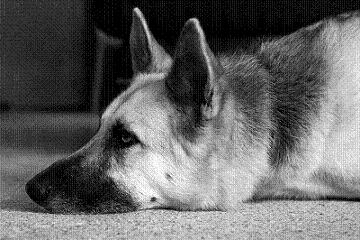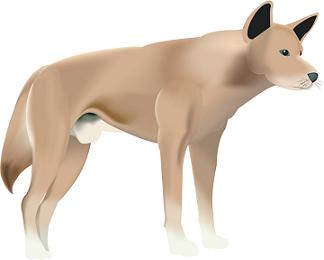Puppy crate training is a fantastic method of managing the safety and well-being of young puppies. When used properly the crate is an invaluable tool for establishing good habits in your puppies and also for preventing problem behaviors before they arise.
In spite of what you may think or have read about puppy crate training the truth is that we crate train our puppies for their benefit - that's why we do it. Secondary to that is the fact that using a crate also benefits us and our furniture, shoes, carpet, cushions etc...

Puppy Crate Training - Why Do We Do It?
Over time the crate will become your puppy's own private area which they will grow to love and feel secure in. You will come to rely on your crate just like I do in many day to day activities including:
- One of the first and most important uses of the crate is in the puppy housebreaking process. Crate training is the best way to quickly teach your puppy to eliminate (go to the toilet) outside. You can read my detailed step by step system here - puppy house training.
- Crating our puppies teaches them to chew on the toys we provide to them and prevents them from chewing on the things we don't want them to chew on (shoes, furniture, curtains etc.). This is the key to establishing good habits in our dogs and preventing destructive habits which can be difficult to rectify.
- When your young puppy is in his/her crate he is safe from any number of dangerous household items. Unfortunately many puppies are severely injured and killed every year as a result of chewing wires, ingesting poisons or eating foreign objects.
- Separation anxiety is a huge problem for an increasingly large percentage of dogs. Proper use of the crate can help reduce the chance of your puppy developing separation anxiety. The crate becomes a place where your dog is calm, out of trouble and accustomed to being alone. I should add here that if you are away from home all day every day is a puppy really suitable for someone with your lifestyle anyway?
Never Ever Use Your Crate As A Tool For Punishment!
- If you have friends or visitors of any kind coming and going from your home the crate is the perfect place to keep your puppy safely confined for a while.
- Because most crates are lightweight and portable you can move them from room to room so your puppy can be close by you all day long!
- Many crates are suitable for putting into your car which makes your puppy's traveling experience safer and often less stressful.
- When your puppy grows to love his crate it makes trips and stays at places such as your Vet and Dog Groomers a more bearable experience.
- When puppy crate training is applied correctly your puppy cannot get into any mischief which significantly reduces any need to discipline her. This makes for a far better environment in which to live (for dog and owner).
- If you plan to do any activities like competitive obedience training, fly-ball or agility training you will find your crate is a great place to confine your dog in between training sessions and competition. Put it in a nice cool spot in the shade. If you plan to give your dog some obedience training I recommend this comprehensive do it yourself dog training course - SitStayFetch Premium.
Selecting A Crate For Your Puppy
The crates basically come in two general styles - durable plastic and an all wire mesh type, which is often collapsible. It's really a personal choice which style of crate you go for but the most important thing is that you buy one that is the appropriate size for your dog. Get a crate that will be large enough for your fully grown puppy and partition it off until he grows into it.
I like the plastic Vari Kennel Crate (the one on the right) style because they are lightweight, tough, can be carted all around the place and they are very easy to clean.
If you plan to purchase your crate online I've always found dog.com to be very good. They have great specials, fast shipping and an enormous range of quality dog crates - click on the crates below to learn more and compare crates.
 |  |
Apart From The Dog What Else Goes In The Crate?
- Bedding - choose a nice comfortable dog bed that can't be chewed up and swallowed by your feisty little pup. Be sure to choose bedding suited to your climate.
- Chew toys - get a couple of good chew toys that you can stuff and even freeze. This keeps your puppy busy and teaches him what is appropriate to chew on. My dogs love Kongs and Buster Cubes.
- Water - keep a nice supply of clean fresh water. Heavy wide based bowls that won't be tipped over are best or you can buy one that clips securely onto the crate wall.
Introducing Your Puppy To The Crate
Your puppy's first impression and experiences with the crate are all important. We need to set it up so your puppy views the crate as a positive object right from the start. You goal is for your puppy to love the crate and choose to use it himself rather than as a contraption he associates with isolation and loneliness.
Try some of the puppy crate training tips below to make the crate inviting to your puppy - always take it slowly. Put the crate in the room with you and your puppy, leave the crate door open wide.
- Drop a few tasty treats in and around the crate and let your puppy clean them up. Be sure to give heaps of encouragement and then praise if your puppy bravely steps into the crate.
- If your puppy has a favorite dog bed or blanket put this inside the crate to encourage him and to make it more homely for him.
- Feed your puppy all of his meals in the crate (door still open).
- With your puppy outside the crate place a chew toy inside the crate and close the door. Your puppy will literally beg you to let him at it! Open up the door, let him in and praise his efforts (this method has proved very successful for my dogs).
- When your puppy is not around tie a chew toy (like a stuffed kong) inside the crate and leave the door open. Let him discover the "treasure" and leave him inside to enjoy the find.
- When your puppy is comfortable in the crate close the door and feed some treats to him through the mesh. To start with just leave the door closed for 10 seconds then gradually increase the duration. Don't increase the time too quickly, if your dog becomes distressed or whines you are moving too fast.
- Build up the amount of time he is in the crate slowly, first when you are in the room, then step outside the room for a short time. Your puppy's first really long stretch in the crate is ideally overnight with the crate in your bedroom.
Puppy Crate Training - Shaping The Behavior
I find that the tips outlined above are more than enough to get most puppies comfortable in their crates. If you are having trouble with a difficult or nervous pup try this puppy crate training exercise to shape the desired behavior.
| 1. Place the crate in an area where you and your puppy spend time together - leave the crate door open. 2. Any time your puppy shows any interest in the crate (like a look) praise him/her and throw him a tasty treat. Repeat this over and over. 3. You'll find that your puppy soon becomes very interested in his crate. This step asks more of your puppy. Don't praise and treat only a glance at the crate now, wait until your pup walks over towards the crate, then enthusiastically praise and reward with a treat. 4. Repeat Step 3 many times and then make it harder again for your puppy to earn a treat. Hold off with your praise and treats until your puppy actually steps in the crate now. Repetition and reinforcing the desired behavior is the key. 5. Now your pup should be popping in and out of the crate to work for his treats. Now you hold off with your praise and treats until your puppy goes into the crate and sits down. 6. The final step is to have your puppy step inside the crate, sit down and then you will close the crate door (only for a few seconds to start with) and feed some treats through the door. 7. Attach a cue word to this process such as "bedtime" or "go to crate". Say your cue word every time your puppy steps inside the crate - he will soon associate the word with the act of getting in to the crate. |
General Rules Of Puppy Crate Training
- Always take your dogs collar off when he is put in the crate. Otherwise the collar can get caught on the crate which can have disastrous consequences.
- Ensure that you aren't asking your puppy (or older dog for that matter) to hold off from going to the toilet for longer than she is physically capable.
- If your puppy does have a toilet accident inside his crate obviously punishment is not an option, but you should be angry at yourself. Immediately clean up the mess including the use of an odor neutralizer.
- Be careful when crating your puppy in hot weather. Be especially careful when you have your puppy crated in your car, temperatures can become extreme inside cars and in a very short period of time.
- Except for overnight and one off occasions you should never crate your dog for more than 4 or 5 hours at a time. Why have a dog if you have to confine him for such long periods? Perhaps a goldfish would be a more suitable pet?
- Dogs love their exercise, particularly nice long walks with you. So if you are going to crate your puppy or older dog they will require plenty of exercise and mental stimulation throughout the day. This can also include some obedience training sessions.
- Never release your puppy from his crate (unless the situation is getting dangerous) if he is causing a fuss by whining, barking or being destructive. If you give in to these demands you are actually rewarding and therefore reinforcing this undesirable behavior.
- Don't fall into the trap of only crating your puppy when you are about to leave the house - the crate will begin to be associated with you leaving if this is the case.
Good luck with your puppy crate training - as long as you follow the above plan with consistency and patience I'm sure you'll achieve great results.
to his/her crate - by a brilliant dog trainer, Dr. Ian Dunbar.
Dogs Time













 ready to respond to your come command. This gives all of us dog owners piece of mind and is very reassuring.
ready to respond to your come command. This gives all of us dog owners piece of mind and is very reassuring. 


 exactly is obedience training, and why is it so important for you and your dog?
exactly is obedience training, and why is it so important for you and your dog?  Greater freedom can also be extended to your dog, as he'll be more trustworthy when obedience trained.
Greater freedom can also be extended to your dog, as he'll be more trustworthy when obedience trained. 















